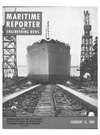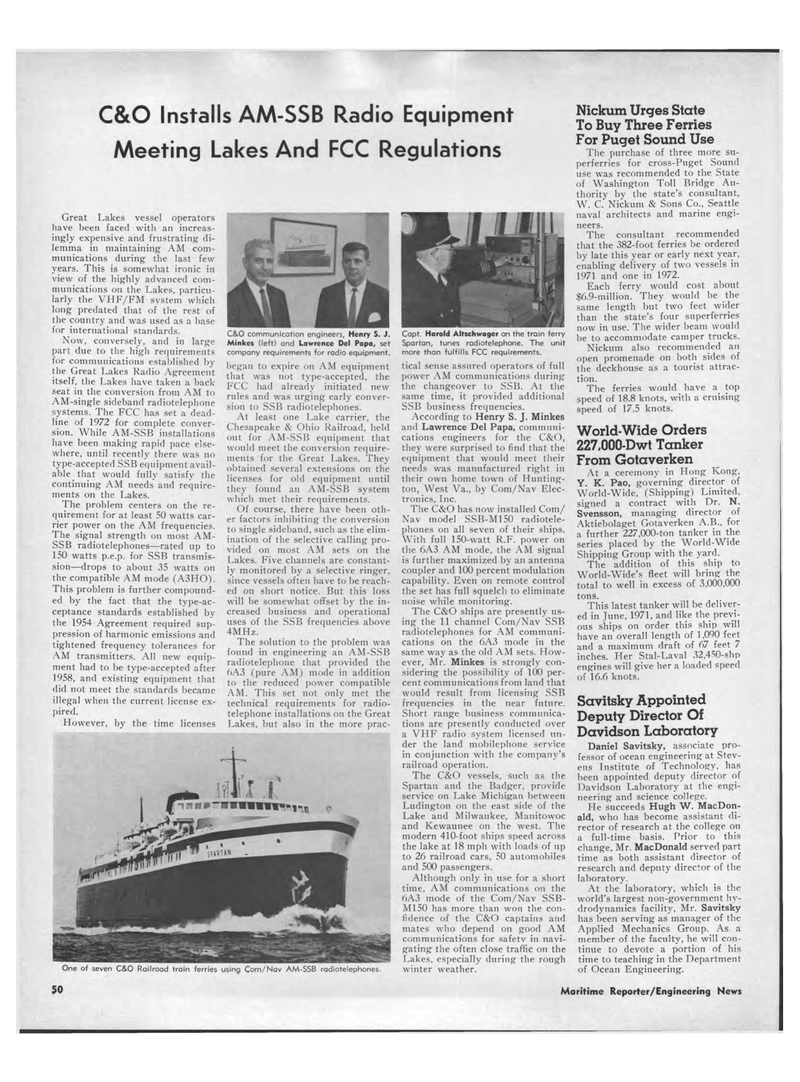
Page 44: of Maritime Reporter Magazine (February 15, 1969)
Read this page in Pdf, Flash or Html5 edition of February 15, 1969 Maritime Reporter Magazine
C&O Installs AM-SSB Radio Equipment Meeting Lakes And FCC Regulations Great Lakes vessel operators have been faced with an increas-ingly expensive and frustrating di-lemma in maintaining AM com-munications during the last few years. This is somewhat ironic in view of the highly advanced com-munications on the Lakes, particu-larly the VHF/FM system which long predated that of the rest of the country and was used as a base for international standards. Now, conversely, and in large part due to the high requirements for communications established by the Great Lakes Radio Agreement itself, the Lakes have taken a back seat in the conversion from AM to AM-single sideband radiotelephone systems. The FCC has set a dead-line of 1972 for complete conver-sion. While AM-SSB installations have been making rapid pace else-where, until recently there was no type-accepted SSB equipment avail-able that would fully satisfy the continuing AM needs and require-ments on the Lakes. The problem centers on the re-quirement for at least 50 watts car-rier power on the AM frequencies. The signal strength on most AM-SSB radiotelephones?rated up to 150 watts p.e.p. for SSB transmis-sion?drops to about 35 watts on the compatible AM mode (A3HO). This problem is further compound-ed by the fact that the type-ac-ceptance standards established by the 1954 Agreement required sup-pression of harmonic emissions and tightened frequency tolerances for AM transmitters. All new equip-ment had to be type-accepted after 1958, and existing equipment that did not meet the standards became illegal when the current license ex-pired. However, by the time licenses C&O communication engineers, Henry S. J. Minkes (left) and Lawrence Del Papa, set company requirements for radio equipment. began to expire on AM equipment that was not type-accepted, the FCC had already initiated new rules and was urging early conver-sion to SSB radiotelephones. At least one Lake carrier, the Chesapeake & Ohio Railroad, held out for AM-SSB equipment that would meet the conversion require-ments for the Great Lakes. They obtained several extensions on the licenses for old equipment until they found an AM-SSB system which met their requirements. Of course, there have been oth-er factors inhibiting the conversion to single sideband, such as the elim-ination of the selective calling pro-vided on most AM sets on the Lakes. Five channels are constant-ly monitored by a selective ringer, since vessels often have to be reach-ed on short notice. But this loss will be somewhat offset by the in-creased business and operational uses of the SSB frequencies above 4MHz. The solution to the problem was found in engineering an AM-SSB radiotelephone that provided the 6A3 (pure AM) mode in addition to the reduced power compatible AM. This set not only met the technical requirements for radio-telephone installations on the Great Lakes, but also in the more prac-Capt. Harold Altschwager on the train ferry Spartan, tunes radiotelephone. The unit more than fulfills FCC requirements. tical sense assured operators of full power AM communications during the changeover to SSB. At the same time, it provided additional SSB business frequencies. According to Henry S. J. Minkes and Lawrence Del Papa, communi-cations engineers for the C&O, they were surprised to find that the equipment that would meet their needs was manufactured right in their own home town of Hunting-ton, West Va., by Com/Nav Elec-tronics, Inc. The C&O has now installed Com/ Nav model SSB-M150 radiotele-phones on all seven of their ships. With full 150-watt R.F. power on the 6A3 AM mode, the AM signal is further maximized by an antenna coupler and 100 percent modulation capability. Even on remote control the set has full squelch to eliminate noise while monitoring. The C&O ships are presently us-ing the 11 channel Com/Nav SSB radiotelephones for AM communi-cations on the 6A3 mode in the same way as the old AM sets. How-ever, Mr. Minkes is strongly con-sidering the possibility of 100 per-cent communications from land that would result from licensing SSB frequencies in the near future. Short range business communica-tions are presently conducted over a VHF radio system licensed un-der the land mobilephone service in conjunction with the company's railroad operation. The C&O vessels, such as the Spartan and the Badger, provide service on Lake Michigan between Ludington on the east side of the Lake and Milwaukee, Manitowoc and Kewaunee on the west. The modern 410-foot ships speed across the lake at 18 mph with loads of up to 26 railroad cars, 50 automobiles and 500 passengers. Although only in use for a short time, AM communications on the 6A3 mode of the Com/Nav SSB-M150 has more than won the con-fidence of the C&O captains and mates who depend on good AM communications for safetv in navi-gating the often close traffic on the Lakes, especially during the rough winter weather. Nickum Urges State To Buy Three Ferries For Puget Sound Use The purchase of three more su-perferries for cross-Puget Sound use was recommended to the State of Washington Toll Bridge Au-thority by the state's consultant, W. C. Nickum & Sons Co., Seattle naval architects and marine engi-neers. The consultant recommended that the 382-foot ferries be ordered by late this year or early next year, enabling delivery of two vessels in 1971 and one in 1972. Each ferry would cost about $6.9-million. They would be the same length but two feet wider than the state's four superferries now in use. The wider beam would be to accommodate camper trucks. Nickum also recommended an open promenade on both sides of the deckhouse as a tourist attrac-tion. The ferries would have a top speed of 18.8 knots, with a cruising speed of 17.5 knots. World-Wide Orders 227,000-Dwt Tanker From Gotaverken At a ceremony in Hong Kong. Y. K. Pao, governing director of World-Wide, (Shipping) Limited, signed a contract with Dr. N. Svensson, managing director of Aktiebolaget Gotaverken A.B., for a further 227,000-ton tanker in the series placed by the World-Wide Shipping Group with the yard. The addition of this ship to World-Wide's fleet will bring the total to well in excess of 3,000,000 tons. This latest tanker will be deliver-ed in June, 1971, and like the previ-ous ships on order this ship will have an overall length of 1,090 feet and a maximum draft of 67 feet 7 inches. Her Stal-Laval 32,450-shp engines will give her a loaded speed of 16.6 knots. Savitsky Appointed Deputy Director Of Davidson Laboratory Daniel Savitsky, associate pro-fessor of ocean engineering at Stev-ens Institute of Technology, has been appointed deputy director of Davidson Laboratory at the engi-neering and science college. He succeeds Hugh W. MacDon-ald, who has become assistant di-rector of research at the college on a full-time basis. Prior to this change, Mr. MacDonald served part time as both assistant director of research and deputy director of the laboratory. At the laboratory, which is the world's largest non-government hy-drodynamics facility, Mr. Savitsky has been serving as manager of the Applied Mechanics Group. As a member of the faculty, he will con-tinue to devote a portion of his time to teaching in the Department of Ocean Engineering. 50 Maritime Reporter/Engineering News

 43
43

 45
45
